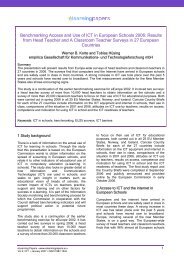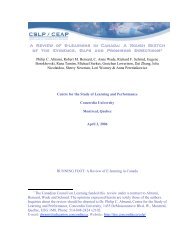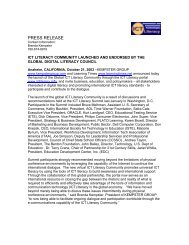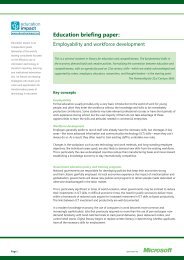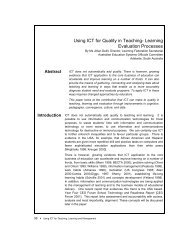147 pages pdf - ICT Digital Literacy
147 pages pdf - ICT Digital Literacy
147 pages pdf - ICT Digital Literacy
Create successful ePaper yourself
Turn your PDF publications into a flip-book with our unique Google optimized e-Paper software.
Testing Here, External Testing There, Quality Assurance Everywhere<br />
#426: Creating Quality: How Can You Produce Cleaner Results Faster?<br />
1. Plan for more than one round of testing. The first round of testing is traditionally called the Alpha test with<br />
the second round usually being called a Beta test. Once you do plan for more than one round of testing,<br />
still attempt to find all of the defects in the first test.<br />
2. Use the 80/20 Rule. Have just a few people test the first round, and have several test in later rounds.<br />
Following the old 80/20 rule, 2-3 people can find the majority of the problems. However, it sometimes takes<br />
several people to uncover the remaining problems.<br />
3. Don’t take any issue for granted. In other words, keep a detailed log of every problem that is found as<br />
well as clear notes about how and when it was resolved. This list can be an important reminder later of why<br />
you made certain decisions along the way, especially if there is ever a difference of opinion among team<br />
members about why an issue was resolved a certain way.<br />
4. Verify every fix. Personally my least favorite part of the process, this step is extremely important. As a<br />
project manager, WBT producer, or one-man-team, you need to make sure that every defect is taken care<br />
of before delivering it to your client. Remember though, if you are the one that made the fix, be sure<br />
someone else verifies the fix for you.<br />
5. Where possible, perform testing micro-cycles. Instead of having all of the testers test at the same time,<br />
then consolidate notes, have them test one at a time and perform quick fixes between testers. Be ready to<br />
get their feedback quickly, even real-time if possible and make the fixes as the issues come in or shortly<br />
thereafter. This allows the next tester to spend his/her time finding other problems for you rather than<br />
submitting the same problems the previous tester submitted. I call these “micro-cycles” because of the<br />
quick turnaround time. Using testing micro-cycles, you’ll get more testing bang for your testing buck.<br />
Garin Hess<br />
Papid Intake<br />
#427: Get Tough On Testing<br />
Have a good testing plan for courseware and never cut corners from testing time. We plan for 5<br />
days of testing time for every course we develop and at least 10 days for 3rd party courses. We<br />
have a checklist of testing requirements that each course must pass. In the event the course<br />
does not pass a requirement, we have a process in place where we return the course to the<br />
developer and project leader for corrections. This keeps everyone in the loop regarding the<br />
status of the project.<br />
Debbie Strong<br />
Country Insurance and Financial Services<br />
#428: Execution = Perfection<br />
e-Learning has to be obviously easy to use so that anybody can figure it out with a minimum scan of the<br />
screen navigation. And every feature must work impeccably. Testing, Testing, Testing!<br />
Sally Heinz<br />
St. Paul Travelers<br />
#429: Get Real<br />
Always test your e-Learning in the environment most similar to the environment that the learner is using.<br />
Joseph Dunlap<br />
Northwestern Mutual Life Insurance<br />
#430: This Is Not Simple Stuff - Learn From Professional Testers<br />
Develop a test plan at the very beginning. If possible, get your organization's Testing & Integration<br />
department to conduct the testing. A good test procedure will be based upon written project requirements.<br />
We are talking about software development and/or systems integration and T&D professionals need to<br />
learn the proper tools to execute these projects efficiently. You cannot wing testing and failure to do proper<br />
testing will result in technical "gotchas" and e-Learning that doesn't satisfy customer requirements.<br />
Tom Swider<br />
701 e-Learning Tips by The MASIE Center www.masie.com 85



